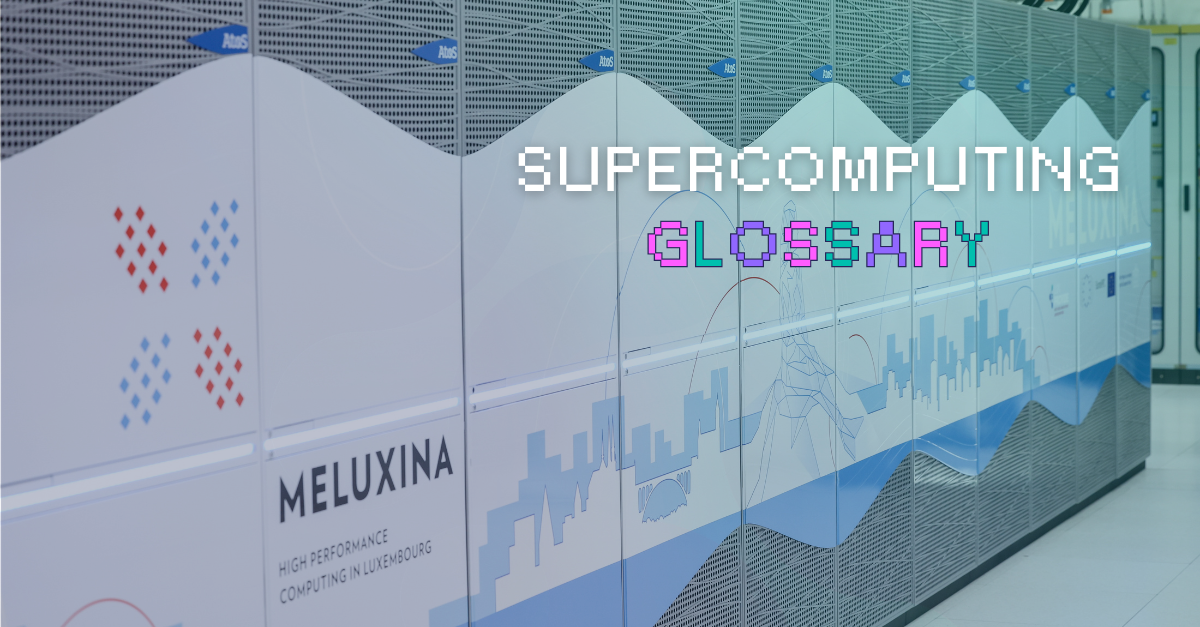
Supercomputing Glossary (A-Z)
June 11, 2024.
Introduction: Supercomputing Glossary
Welcome to the Comprehensive Supercomputing Glossary by LuxProvide, your go-to resource for understanding the intricate world of high-performance computing. Whether you are new to supercomputing or a seasoned professional, this glossary is designed to demystify the terminology and concepts that drive the industry.
From fundamental terms like algorithms and cloud computing to advanced topics such as exascale computing and quantum computing, our glossary provides clear and concise definitions to help you navigate the complexities of supercomputing.
As the company behind the powerful MeluXina supercomputer, LuxProvide is committed to making cutting-edge technology accessible and comprehensible. Dive in and expand your knowledge of the technologies that are shaping the future of computing.
A
Algorithm: A set of rules or steps used to solve a problem or perform a computation. In supercomputing, algorithms are crucial for processing large datasets efficiently.
Artificial Intelligence (AI): The simulation of human intelligence in machines that are programmed to think and learn. AI applications often require significant computational power, making supercomputers ideal for AI research and development.
AI Compliance: Ensuring that AI systems meet legal, ethical, and technical standards. This includes adhering to regulations, privacy laws, and ethical guidelines in AI development and deployment.
B
Backup: The process of creating copies of data to protect against loss, corruption, or disaster. In supercomputing environments, backups are critical for ensuring data integrity and availability, allowing recovery of important datasets and system configurations in case of hardware failure, software issues, or other disruptions.
Big Data: Extremely large datasets that require advanced tools and techniques for analysis, storage, and visualization. Supercomputers are used to process big data quickly and efficiently.
C
Cloud Computing: The delivery of computing services over the internet. While different from supercomputing, cloud computing can complement supercomputing by providing scalable resources.
Cluster: A set of connected computers that work together as a single system. Supercomputing clusters are designed to provide high-performance computing capabilities.
Compute Node: An individual computer within a supercomputer. Each node typically consists of multiple processors and memory units.
Consulting: Professional advisory services provided to help organizations optimize their use of supercomputing resources. Consulting services may include system design, performance tuning, and strategic planning
CPU (Central Processing Unit): The primary component of a computer that performs most of the processing inside a computer. In supercomputers, multiple CPUs are used to increase processing power.
D
Data Analytics: The process of examining large datasets to uncover hidden patterns, correlations, and insights. Supercomputers are used to perform advanced data analytics at high speeds.
Data Center: A facility used to house computer systems and associated components, such as telecommunications and storage systems. Supercomputers are typically housed in dedicated data centers.
Data Parallelism: A type of parallel computing where the same operation is performed simultaneously on different pieces of distributed data. This technique is often used in supercomputing to speed up processing.
Data Sovereignty: The concept that data is subject to the laws and governance structures of the nation where it is collected. Ensuring data sovereignty is crucial for compliance with local regulations.
Deep Learning: A subset of machine learning involving neural networks with many layers. Supercomputers are often used to train deep learning models due to their high computational demands.
Digital Twin: A virtual model of a physical object, process, or system that is used to simulate, analyze, and optimize performance. Supercomputers enable the creation and management of complex digital twins
E
Exascale Computing: Refers to computing systems capable of performing at least one exaflop, or a billion billion (10^18) calculations per second. Exascale supercomputers represent the next frontier in computational power.
F
FPGA (Field-Programmable Gate Array): A type of integrated circuit that can be configured by the customer or designer after manufacturing. FPGAs are used in various applications that require customizable hardware functionality, including supercomputing. They offer high performance and flexibility for specific tasks such as data processing, signal processing, and hardware acceleration.
Floating-Point Operations Per Second (FLOPS): A measure of computer performance, especially in fields of scientific calculations that make heavy use of floating-point calculations. One petaflop equals one quadrillion (10^15) FLOPS.
File System: The method and data structure that an operating system uses to manage files on a disk or partition. High-performance file systems are critical in supercomputing environments to handle large volumes of data efficiently.
G
Giga: A prefix in the metric system denoting a factor of 10^9, or one billion (1,000,000,000). In computing, “giga” is commonly used to describe data storage capacity and processing power, such as gigaflops (billion floating-point operations per second) and gigabytes (billion bytes of data).
GPU (Graphics Processing Unit): A specialized processor designed to accelerate graphics rendering. GPUs are also used in supercomputing to accelerate complex computations.
H
High-Performance Computing (HPC): The use of supercomputers and parallel processing techniques for solving complex computational problems.
Hybrid Computing: Combining different types of computing technologies, such as using both CPUs and GPUs, to maximize performance and efficiency in supercomputing tasks.
I
Interconnect: The physical and logical connection between different computing elements in a supercomputer. High-speed interconnects are essential for efficient data transfer between nodes in a supercomputer.
I/O (Input/Output): The communication between an information processing system (such as a computer) and the outside world. Efficient I/O operations are critical in supercomputing for handling large datasets.
ISO 27001: An international standard for managing information security. Compliance with ISO 27001 ensures that an organization has implemented and maintained an effective information security management system
L
Latency: The time delay between the initiation and completion of a process. In supercomputing, low latency is crucial for efficient processing.
Large Memory Models: Computing architectures or configurations designed to support and utilize a substantial amount of memory, often exceeding the capabilities of standard systems. Large memory models are crucial in supercomputing for handling extensive datasets and running memory-intensive applications, such as scientific simulations, big data analytics, and complex computational tasks.
LLM (Large Language Model): A type of AI model that has been trained on vast amounts of text data to understand and generate human language. Supercomputers are often used to train and run large language models.
M
Machine Learning (ML): A subset of AI that involves the use of algorithms and statistical models to enable computers to improve their performance on a task with experience.
Made in Luxembourg: Products or services that are developed or manufactured in Luxembourg, emphasizing local quality and innovation. LuxProvide and MeluXina are examples of high-tech initiatives made in Luxembourg.
Massively Parallel Processing (MPP): A type of computing architecture where many independent processors execute different parts of a program simultaneously. Supercomputers often utilize MPP to achieve high performance.
N
Network Topology: The arrangement of various elements (links, nodes, etc.) in a computer network. In supercomputing, efficient network topology is crucial for optimal performance.
Node: An individual computer within a supercomputer that works together with other nodes to perform large-scale computations. Each node typically contains multiple processors and memory units.
Numerical Simulation: A computational technique used to model and study the behavior of complex systems by solving mathematical equations numerically. In supercomputing, numerical simulations are employed in various fields such as physics, engineering, climate science, and finance to predict and analyze the performance and dynamics of systems under different conditions.
P
Parallel Computing: A type of computation in which many calculations or processes are carried out simultaneously. Supercomputers rely heavily on parallel computing to achieve high performance.
Peta: A prefix in the metric system denoting a factor of 10^15, or one quadrillion (1,000,000,000,000,000). In computing, “peta” is often used to describe the capacity of supercomputers and data storage systems, such as petaflops (quadrillion floating-point operations per second) and petabytes (quadrillion bytes of data).
Petaflop: A measure of a computer’s speed, equivalent to one quadrillion (10^15) floating-point operations per second. Modern supercomputers operate at petaflop or even exaflop scales.
Petascale Computing: Refers to computing systems capable of performing at least one petaflop, or a quadrillion (10^15) calculations per second.
Private AI: AI systems designed with enhanced privacy measures to protect sensitive data. Supercomputers help in developing and running private AI models while ensuring data security.
Q
Quantum Computing: An emerging field of computing based on the principles of quantum mechanics. While different from classical supercomputing, it represents a potential future direction for high-performance computing.
S
Scalability: The capability of a system to handle a growing amount of work by adding resources to the system. Supercomputers must be highly scalable to manage increasing computational demands.
SSH Key (Secure Shell Key): A pair of cryptographic keys used for secure access to remote computers and servers over an unsecured network. SSH keys provide a more secure authentication method than passwords by using public-key cryptography. In supercomputing, SSH keys are commonly used to grant secure access to supercomputing resources, ensuring that only authorized users can access sensitive data and computational power.
Supercomputer: A highly advanced computing machine designed to perform extremely complex calculations at high speeds. Supercomputers are used in a variety of fields, including scientific research, weather forecasting, and complex simulations.
Support: Assistance provided to users of supercomputing resources to help them effectively utilize the technology. Support services may include technical help, training, and troubleshooting.
Symmetric Multiprocessing (SMP): A type of computing architecture where multiple processors share a single, main memory space and are controlled by a single operating system instance. SMP is used in supercomputers to enhance performance.
T
Tera: A prefix in the metric system denoting a factor of 10^12, or one trillion (1,000,000,000,000). In computing, “tera” is commonly used to describe data storage capacity and processing power, such as teraflops (trillion floating-point operations per second) and terabytes (trillion bytes of data).
Tier IV: The highest level of data center reliability and availability as defined by the Uptime Institute. A Tier IV data center offers redundant systems and 99.995% uptime, ensuring continuous operation of critical services.
Training: The process of teaching or learning specific skills or knowledge. In supercomputing, training often refers to educating users on how to effectively use supercomputing resources and tools.
U
User Interface (UI): The means by which the user interacts with a computer system. In supercomputing, the UI must provide efficient ways for users to submit jobs and monitor performance.
V
VM (Virtual Machine): A software-based emulation of a physical computer that runs an operating system and applications just like a physical computer. In supercomputing, VMs allow for the efficient utilization of hardware resources by enabling multiple operating systems to run on a single physical machine, providing isolation, scalability, and flexibility for various computational tasks.
Visualization: The process of creating graphical representations of data or computational results. Visualization tools are essential for interpreting the output of supercomputing simulations.
VPN (Virtual Private Network): A technology that creates a secure and encrypted connection over a less secure network, such as the internet. In supercomputing, VPNs are used to provide secure remote access to supercomputing resources, ensuring data privacy and protection while connecting users from different locations to the centralized computing infrastructure.
W
Workload Management: The process of managing the tasks that need to be performed by a computer system. In supercomputing, effective workload management ensures that resources are used efficiently.
Supercomputing Glossary


